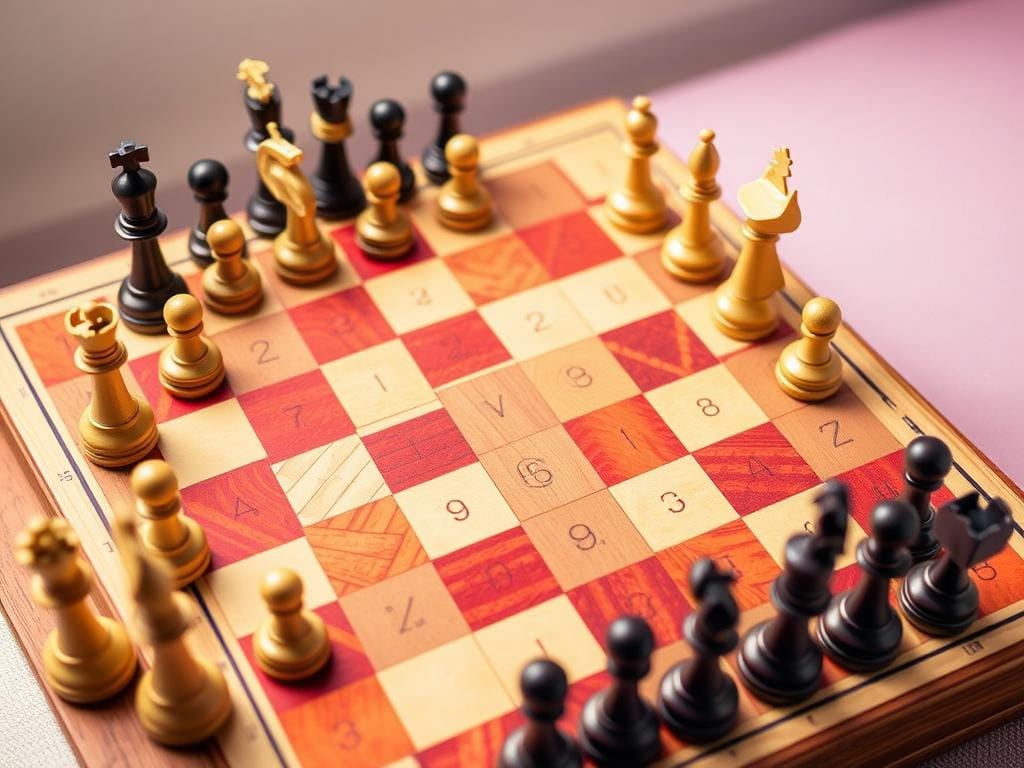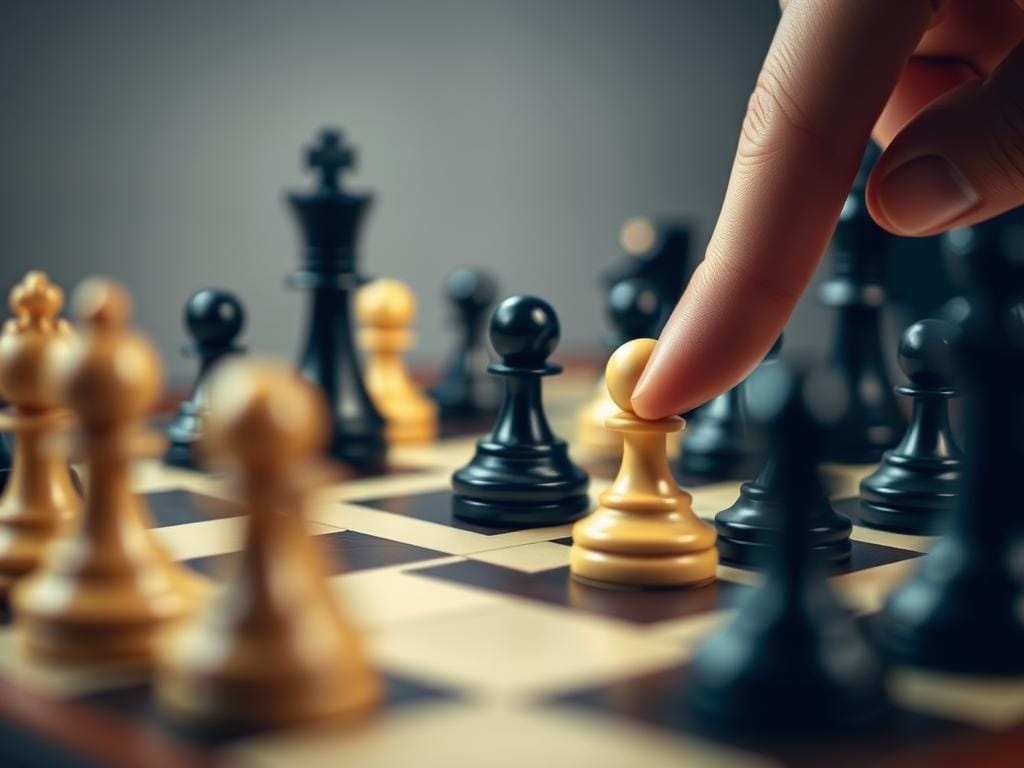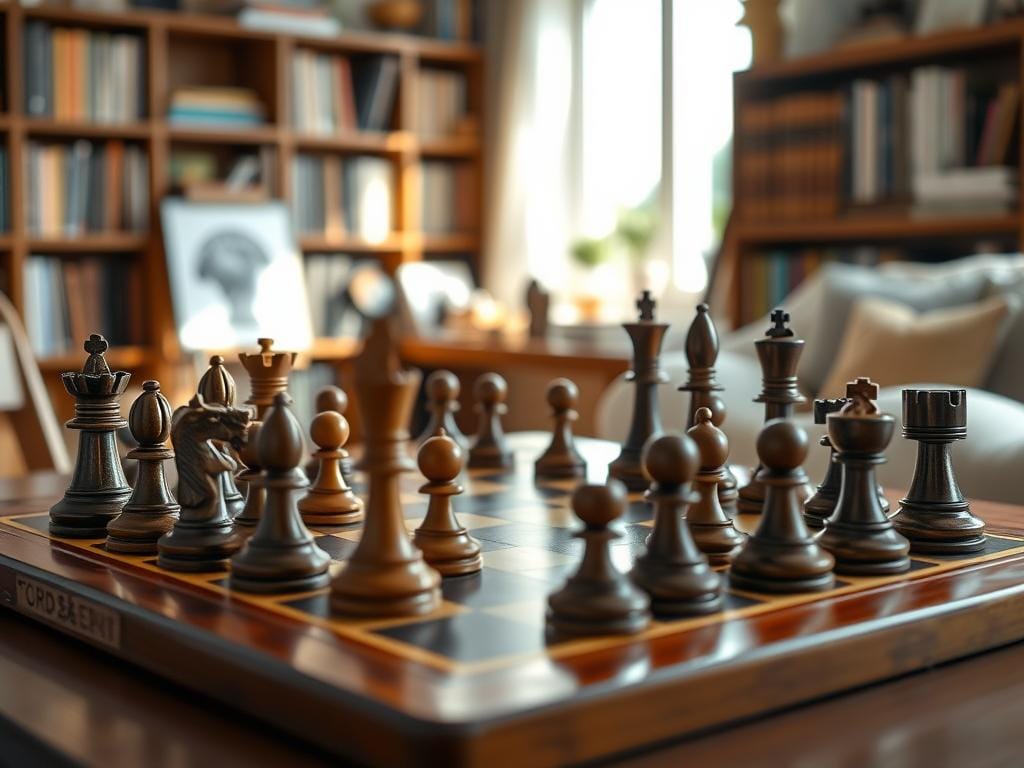Did you know chess has more possible moves than atoms in the universe? Chess is not just a game for kings and queens. It’s a vast world calling strategic minds to explore. This journey from beginner to powerful player will be exciting.
Starting this journey opens a chest full of tips for chess newbies. I’ll show you everything from smart opening moves to tactics loved by both grandmasters and new players.
Let’s dive into the chess world, where every move tells a story. Every game is an adventure. Get ready to discover the mysteries of those 64 squares. They offer a unique way to challenge your mind and have fun.
Key Takeaways
- Mastering chess opens up a universe of strategic possibilities.
- Uncover essential chess tips for novices eager to understand the game.
- Grasping the basics for a tactically sound chess opening for beginners.
- Learning chess provides enriching mental exercise and enjoyment.
- Every chess piece is a character in the story of your strategic journey.
Chess Basics for Newcomers
Welcome to the exciting world of chess! If understanding chess rules for beginners and learning chess basics for newcomers are your goals, you are in the right spot. We will start with how to understand the board and set it up for your first game.
Understanding the Chessboard and Setup
The chessboard is a square with 64 smaller squares, alternating in light and dark colors. Setting up the board right is key to mastering chess basics for newcomers. Each player begins with 16 pieces. This includes eight pawns, two knights, two bishops, two rooks, one queen, and one king.
The pawns fill the second row from each player. Your rooks go in the corners, with knights next to them, bishops next, and the queen and king in the center on their colors.

Setting this up might seem easy, but each piece’s potential is huge, depending on where they are and your plan.
The Unique Movements and Value of Each Piece
Knowing how each chess piece moves is key for those wanting to master chess rules for beginners. Let’s look at each piece’s unique move:
- Pawns: They move forward one square but capture diagonally. On their first move, they can go two squares.
- Rooks: They move straight across any number of squares, either horizontally or vertically.
- Knights: They move in an ‘L’ shape: two squares in one direction, then one square to the side, jumping over pieces.
- Bishops: They move diagonally over any number of squares.
- Queen: She has the power of both the rook and bishop and can move any direction.
- King: Moves one square any way, the most key but at risk piece.
Each piece’s value and power are key to your game plan. Maybe you’ll advance a pawn to be promoted or do a knight fork. Chess offers endless possibilities.
With these basics, you’re on your way to having fun and doing well in chess. Now, you’ll use these chess basics for newcomers in real games. Building strategies from these skills can give you the upper hand.
How to Play Chess for Beginners
Learning how to play chess can be thrilling but tough. It’s key to know the basic rules and starting strategies. These foundational principles help you do well in chess.
Basic Chess Rules to Kickstart Your Game
Chess has rules that control how pieces move and interact. The goals are capturing pieces, achieving check, and getting checkmate. There are also special moves like ‘en passant’ and ‘castling’ which add surprises.
Knowing these rules helps you create good strategies for beginners.
Opening Moves and Strategies
The start of a chess game is very important. It sets up the game. You should control the center, develop your pieces, and keep your king safe.
- Control the Center: Taking over the center gives you freedom to move your pieces and limits the opponent.
- Develop Your Pieces: Getting knights and bishops out early helps your game later on.
- King Safety: Castling early is important to keep your king safe.
These tips will make your defense strong and let you play more aggressively. Knowing these basics greatly helps with managing the game early on.

Improving Your Game: Beginner Chess Strategies
Mastering chess needs a balance of defense and attack, especially for beginners. In this segment, we’ll look at how beginners can develop their chess strategies. Understanding when to defend and when to attack is key. We will also discuss anticipating your opponent’s moves and knowing your next move.
Defensive Play vs. Offensive Opportunities
For beginners, knowing when to shift between defense and offense can change your game. Defense is about protecting your king and keeping a solid structure. Meanwhile, you should look for a chance to go on the offense. On the flip side, seeing an offensive chance can let you control the game and win.
“The best defense is a good offense.”
This saying is very true in chess. By switching between defense and attack, you make your opponent unsure. This can cause them to make mistakes. Here are some tips for beginners:
- Keep your pawns structured for defense and as a base for attacks.
- Control the board’s center to open more paths for your pieces, both for defense and for attacking.
- Always watch for what your opponent might do — sometimes, playing defense can stop their plans early.
Planning and Timely Execution
Chess is about planning moves ahead, not just the current move. This planning is vital for strong beginner strategies. You must also execute these plans at the right time. Rushing or waiting too long can mess up your strategy and give your opponent an edge.
- Make a plan that can change as the game goes on.
- Always check the board. Try to improve your position or mess up your opponent’s plans with each move.
- Know when to strike. Find when your opponent is weak and use that to win the game.
Getting good at both defense and offense, along with planning and acting correctly, can make you a much better player. Now, let’s look at some strategies with a diagram.

Practice these tips to get better at defense and offense. This will make you more balanced at chess. Remember, all chess masters started as beginners. Mastering these basic strategies is the foundation for moving to advanced levels.
Conclusion
Starting to learn chess is both exciting and tough. We’ve learned the basics, from knowing the chessboard to using each piece wisely. It’s clear that knowing these tips is just the beginning. Chess is about patience, practice, and always learning more.
I urge you to keep going back to these basics. Join the chess community, share strategies, and learn from others who love the game. Remember, all grandmasters began as beginners. Every game is a chance to get better at chess. Enjoy solving puzzles and looking at games—they’re great for your strategy skills.
So, what’s your next move? The chessboard is waiting! Use what you’ve learned here and play each game with excitement and smart planning. Let defense and offense ideas, opening moves knowledge, and understanding each piece’s power help you. A good strategy can help you beat your opponent. So, get your chessboard ready, channel your inner Beth Harmon, and explore the rich game of chess.
























